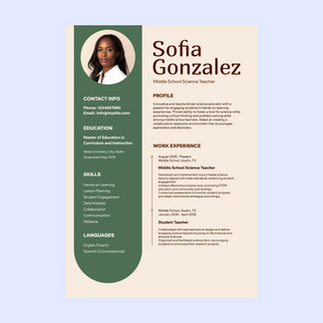- Ruth Kogan
- Aug 7
- 9 min read
Updated: Dec 10

What makes a resume unforgettable? Beyond listing your experience, a well-crafted resume reflects your professional personality and creativity. It’s more than just a document; it’s an opportunity to tell your story and showcase what sets you apart. When you create a resume, incorporating unique design ideas can help it stand out and leave a lasting impression. However, keep in mind that 40% of recruiters will be put off by an inappropriate design of a resume, so it’s crucial to strike the right balance.
This article dives into fresh graphic design ideas and resume templates that will elevate your resume. It offers practical tips and insights into how to write a resume with functional and visually striking layouts. From breaking down design essentials to exploring ways to balance creativity with professionalism, you’ll walk away with the tools and confidence to create a resume that leaves a strong, lasting impression.
Start building your personal marketing strategy today, and set yourself apart with a resume that truly reflects your unique story.
Stand out in the job market with our powerful resume builder. Select from professional templates and customize every detail to highlight your skills, experience and career aspirations. Create a polished, attention-grabbing resume that leaves a lasting impression.
TL;DR: 23 resume design ideas to stand out
This article provides 23 creative resume design ideas to help you craft a professional and visually appealing resume. It emphasizes balancing creativity with professionalism, offering tips on layout, color schemes, fonts, and visual elements. The guide also includes practical advice on tailoring resumes for specific industries, making them ATS-friendly, and ensuring they highlight key information effectively.
23 resume design ideas with example templates
01. Start strong, leave an impression
Your resume’s opening sets the stage for everything that follows—it’s your first opportunity to grab attention. Include a headline or summary that highlights your top skills and achievements in just a few sentences. This creates a compelling start and sets you apart from a sea of resumes.
02. Space it out for clarity
Good design requires breathing room. Use consistent spacing between sections and lines to avoid an overcrowded look. Adding whitespace helps guide the reader’s attention and makes your resume feel approachable and easy to read.
03. Add visual elements for impact
A clean, professional design can benefit from subtle visual touches. Use dividers, icons or shaded backgrounds to break up the text and redirect the eye. Visual elements help create focus and balance, keeping your resume both functional and memorable.
04. Put the spotlight on what matters
Make sure to highlight key information by using headers, bold text or a pop of color. For example, emphasize your name, job titles or core skills. This ensures hiring managers see your most important qualifications at a glance.
05. Craft a coordinated color palette
A unified color scheme—two or three complementary tones—is an easy way to elevate your design. Use a color palette generator to find harmonious combinations. Choose muted colors for text and gentle accents for dividers or titles. This delivers a polished, intentional feel that reflects professionalism.
06. Flip tradition for creativity
By rethinking standard layouts, you can add visual interest. Try placing your contact details in a sidebar or grouping experience into clusters for a modern look. A unique design approach demonstrates originality while staying professional.
07. Follow an elegant minimalist approach
Minimalist designs focus on clean lines, spacious layouts and thoughtful use of color. A structured, uncluttered resume ensures clarity and lets the content shine. A muted color accent used sparingly can draw attention without being too flashy.
08. Build a modular layout
Segment your resume into clean, defined sections or blocks. This modular approach makes it easy for recruiters to focus on each part separately, while improving readability and organization for the entire document.
Design your resume in minutes with AI resume builder.
09. Add a crisp border for refinement
A border creates natural boundaries for your resume content, giving it a feeling of structure and completeness. Opt for simple, thin lines that enhance the layout without overpowering it. A well-defined edge adds a touch of sophistication.
10. Highlight with a single accent color
Accentuate headers, section dividers or important data with a tasteful pop of color. A well-chosen tone—like navy blue, burgundy or emerald—enhances your design without detracting from the professionalism of the layout.
11. Add focus with subtle icon headers
Icons enhance visual interest without crowding the page. Pair clean, recognizable symbols with section titles like “Experience” or “Skills,” adding personality and helping readers quickly find the information they need.
12. Use a monogram to add a personal touch
A monogram is a sophisticated way to stamp your identity onto your resume. Whether it’s an elegant logo of your initials or a watermark-style background design, this little detail screams refinement. It’s a classy touch that blends function and personal flair effortlessly.
13. Pick a theme that aligns with your industry
Your industry can inspire the overall feel of your resume and elevate your personal branding. Creative professions might enjoy bolder layouts, while more traditional roles call for clean, classic designs. Matching your resume’s theme to your industry not only enhances your branding, but also subtly communicates that you understand its norms and values.
According to Caroline Mignaux, co-founder of Agence Personnelle and host of Marketing Square podcast:
"Personal branding is about promoting your skills, experience and personality as a brand."
14. Add humor to make your resume memorable
When appropriate, a touch of humor can make your application stand out. A lighthearted tagline or clever section title can add charm without veering into unprofessional territory. Carefully placed, humor can show that you’re approachable and confident—even under job hunt pressure.
15. Get to the point with concise content
Make every word count by trimming unnecessary fluff. Use crisp, impactful sentences to communicate your experience without overwhelming the reader. An efficient resume exudes professionalism and respects the time of busy hiring managers.
16. Pack in relevant information without overwhelming
It’s a fine line between detail and overload. Use strategic formatting—like bullet points—to break up dense information. This way, you include all the essentials without forcing anyone to hunt for the key takeaways.
17. Include a timeline to visualize your education or experience
Timelines are a simple, yet effective way to illustrate your career progress. Opt for a clean and subtle design that plots key milestones, such as graduation dates or periods of employment at specific companies. This structure makes your accomplishments easy to follow at a glance.
18. Showcase your skills with a visually appealing design
Highlight your skills using creative elements like skill bars, pie charts or categorized lists. These tools visually communicate your competencies without heavy text. A well-crafted skills section ensures the reader immediately understands your strengths.
19. Highlight your contact information with a background color
Make critical details, like your email and phone number, easy to spot by placing them against a shaded background. A soft but distinct color adds emphasis without disrupting the design. This small adjustment ensures recruiters find your info in seconds.
20. Add direct links to your social media platforms
If you have a polished LinkedIn profile or professional portfolio, link it directly in your resume. Use clean hyperlink text or simple icons for a sleek addition. This saves recruiters time and gives them a fuller picture of your experience at their fingertips.
21. Encourage interaction with clickable links
Turn your static resume into an interactive document by embedding hyperlinks to your email, portfolio or LinkedIn. This modern touch not only looks sleek, but also makes it effortless for recruiters to connect with you.
22. Design a data-driven infographic resume
Infographic-style resumes deliver maximum information in highly visual formats. Incorporate pie charts, timelines or bar graphs to highlight skills, achievements and experiences. These resumes combine creativity and clarity, making complex data easy to absorb.
Learn more about what is an infographic.
23. Choose fonts that say “hire me”
Stick with clear, professional fonts like Calibri, Garamond or Helvetica—avoid decorative styles that distract from your experience. Keep text between 10–12 points, use larger headings for structure and focus on easy readability to make a strong, polished impression.
Tips for effective resume distribution
Customize your resume: Tailor your resume for each job application to highlight the skills and experience most relevant to the role.
Use professional networking sites: Leverage platforms like LinkedIn to showcase your resume and connect with potential employers.
Attend job fairs or career events: Bring physical copies of your resume to share and network with recruiters in person.
Utilize online job search engines: Search for openings on job boards and company career pages, and submit your resume directly to hiring managers.
Reach out to industry contacts: Ask your professional contacts about job opportunities, and if they can share your resume with decision-makers.
Consider working with a recruiter: Recruiters or staffing agencies can help match you with job openings and distribute your resume for you.
Try Wixel's CV Maker today.
What a resume should include
Design alone isn’t enough—a great resume requires the right content. Make sure you include these essential sections to ensure it serves both form and function.
Contact information
At the top of your resume, list your name, phone number, email address and LinkedIn profile (if applicable). Ensure this section is clean, straightforward and free of clutter—this is how potential employers will reach out.
Professional summary or objective
Your professional summary is a brief introduction to who you are and what you bring to the table. For example, a content creator might write, “Creative and resourceful content strategist with expertise in social media campaigns and audience engagement.” Keep it concise—2-3 sentences are perfect.
Work experience
Organize your professional history in reverse-chronological order, emphasizing accomplishments rather than duties. Quantify your achievements when possible, using data or percentages to make a greater impact. For example, “Reduced campaign costs by 15% while increasing engagement by 30%.”
Education and certifications
Include your educational background, as well as any relevant certifications or courses. Highlight degrees, diplomas and ongoing learning experiences that relate to the position you’re applying for.
Skills and technical proficiencies
Provide a clear list of your core skills, such as software proficiencies, technical abilities or soft skills relevant to the field. Use bullet points or columns to prevent this section from feeling crowded.
Optional sections
Depending on your industry, you might add sections like “Projects,” “Volunteer Experience,” or “Languages.” Tailor these based on your experience and the role you're applying for.
Find inspiration for your next project with these creative design ideas:
Background ideas to inspire your next design project
Banner design ideas to grab attention and stand out
Book cover ideas to sell your story
Brochure ideas to elevate your marketing strategy
Facebook cover photo ideas to engage your audience and capture attention
Flyer design ideas to promote your next big event
Holiday card design is so cookie-cutter: here are 4 ways to break the mold
Infographic ideas to inspire your next visual story
LinkedIn banner ideas to make your profile stand out
Packaging design ideas to elevate your product’s appeal
Poster design ideas to make a powerful visual statement
Presentation ideas to bring your slideshow to life
Resume design ideas FAQ
How many pages should my resume be?
Keep your resume concise—ideally one page. If you're an experienced professional with significant achievements, a two-page resume is acceptable, but place the most critical info on the first page.
What is the best font to use for resumes?
Choose professional, easy-to-read resume fonts like Calibri, Garamond and Helvetica. Avoid decorative fonts that may look unprofessional or make it hard for employers to read quickly. Use 10-12 point size for text and slightly larger for headings.
Should my resume include photos?
This depends on the industry and location. While creative roles might benefit from having a headshot, many locations and industries prefer text-only resumes to reduce the risk of bias. Research industry norms before including a photo.
How often should I update my resume?
Update your resume whenever you’ve made significant achievements or gained new skills. Regular updates ensure you’re always prepared to apply for opportunities when they arise.
How can I make my resume ATS-friendly?
Many companies use applicant tracking systems (ATS) to process resumes. To ensure yours is parsed correctly, stick to simple formats without excessive digital design elements, avoid using images instead of text and use common fonts. Save your document as both a plain-text version and a PDF for best results.



















































